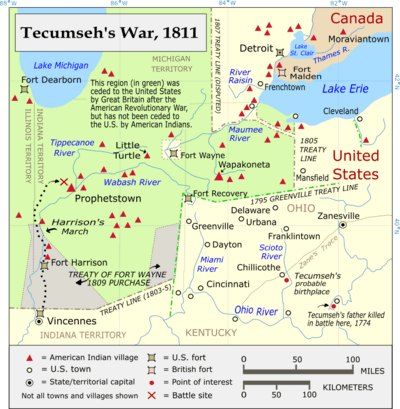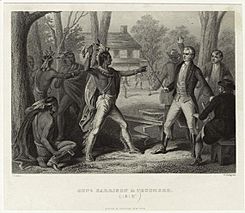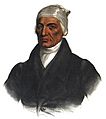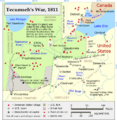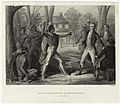Tecumseh's War facts for kids
Quick facts for kids Tecumseh's War |
|||||||
|---|---|---|---|---|---|---|---|
| Part of the American Indian Wars and the War of 1812 | |||||||
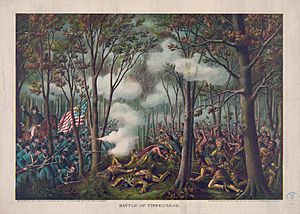 Battle of Tippecanoe |
|||||||
|
|||||||
| Belligerents | |||||||
| Tecumseh's Confederacy Supported by: |
|||||||
| Commanders and leaders | |||||||
| Tecumseh † Tenskwatawa |
James Madison William Henry Harrison |
||||||
Tecumseh's War was a fight between the United States and a group of Native American tribes. This group was called Tecumseh's Confederacy. It was led by a brave Shawnee leader named Tecumseh. The war mostly happened in the Indiana Territory.
Many people think the main part of the war ended in 1811. This was after William Henry Harrison won the Battle of Tippecanoe. But Tecumseh's War actually kept going into the War of 1812. It's often seen as part of that bigger conflict. The war finally ended in 1813. Tecumseh and his second-in-command, Roundhead, died fighting Harrison's army. This happened at the Battle of the Thames in Upper Canada. After this, Tecumseh's Confederacy broke apart.
Contents
Why the War Started
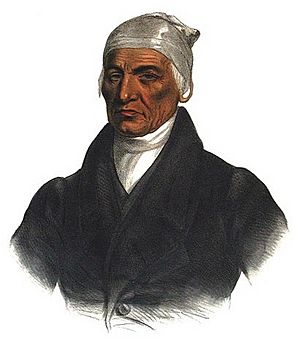
The two main leaders in this war were Tecumseh and William Henry Harrison. Both had been involved in an earlier battle in 1794. This was the Battle of Fallen Timbers, which ended the Northwest Indian War. Tecumseh did not sign the Treaty of Greenville. This treaty gave a lot of land in what is now Ohio to the United States. This land had been home to the Shawnee and other Native American tribes for a long time.
After the Treaty of Greenville, many Ohio Shawnees settled in a village called Wapakoneta. Their leader was Black Hoof, an older chief who had signed the treaty. Another leader, Little Turtle of the Miamis, also signed the treaty. Both Black Hoof and Little Turtle believed in trying to get along with the United States. They thought Native Americans should adapt to American ways.
Over time, more treaties were signed. These included the Treaty of Grouseland and the Treaty of Vincennes. These treaties recognized American ownership of most of southern Indiana. They helped ease tensions by allowing settlers into Indiana. Native Americans also received payments for the lands that settlers were moving onto.
A New Religious Movement
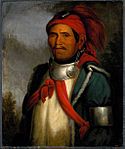
In 1805, a very important Native American leader named Buckongahelas died. Many tribes thought his death was caused by witchcraft. This led to a "witch-hunt" where some people were accused and killed. During this time, Tecumseh's brother, Tenskwatawa, became a new religious leader. He was known as "The Prophet."
Tenskwatawa taught Native Americans to reject European American ways. He told them to avoid alcohol, European clothes, and firearms. He also said that tribes should not sell any more land to the United States. Many Native Americans who wanted to cooperate with the U.S. were accused of witchcraft. Some were even killed by Tenskwatawa's followers.
By 1808, tensions grew between Tenskwatawa's followers and white settlers. There were also problems with the Shawnees in Wapakoneta. So, Tenskwatawa and Tecumseh moved further northwest. They built a new village called Prophetstown. It was near the Wabash River and Tippecanoe River. This land was claimed by the Miami tribe. Little Turtle told the Shawnee they were not welcome there, but they stayed.
Tenskwatawa's religious teachings became more popular and more aggressive. He attracted many Native American followers from different nations. These included Shawnee, Iroquois, Miami, Potawatomi, and Wyandot.
In 1808, Tecumseh started to become a leader. The British in Canada offered him an alliance, but he said no. The Americans first noticed him in 1810. Tecumseh eventually became the main leader of the confederacy. But his younger brother's religious ideas helped build its foundation.
Prophetstown became the biggest Native American community in the Great Lakes area. It was a major cultural and religious center. Thousands of Native Americans gathered there to find spiritual strength.
Indiana Territory Land Deals
In 1800, William Henry Harrison became the governor of the new Indiana Territory. Its capital was Vincennes. Harrison wanted to get Native American lands for American settlers. He hoped that enough white settlers would move to Indiana for it to become a state. Harrison made many treaties to get land from Native American tribes.
In 1809, Harrison wanted another treaty to open more land for settlement. The Miami, Wea, and Kickapoo tribes strongly opposed selling more land around the Wabash River. To get them to sell, Harrison decided to make a treaty with tribes who were willing. He hoped they would then convince the others.
In September 1809, Harrison invited the Potawatomi, Lenape, and Miami to a meeting in Fort Wayne. He promised them large payments if they would give up the lands he wanted. Only the Miami tribe opposed the treaty. They showed their copy of the Treaty of Greenville. It guaranteed their ownership of the lands around the Wabash River.
The Miami were worried because the Wea leaders were not there. The Wea were the main people living on the land being sold. The Miami also wanted to be paid by the acre, not by a large section. Harrison agreed that the treaty needed approval from the Wea and other tribes. But he refused to buy land by the acre. He said it was better for tribes to sell large sections. This would stop Americans from only buying the best lands and leaving them with poor land.
After two weeks, the Potawatomi leaders convinced the Miami to accept the treaty. The Treaty of Fort Wayne was signed on September 30, 1809. It sold over 3 million acres (about 12,000 square kilometers) to the United States. Most of this land was along the Wabash River. Harrison then got the Wea to accept the treaty by offering them a large payment. He also offered the Wea more money if the Kickapoo would accept it too. This made the Wea pressure the Kickapoo leaders. By spring 1810, the Treaty of Fort Wayne was complete.
The Conflict Begins
Tecumseh was furious about the Treaty of Fort Wayne. After this, he became a very important political leader. Tecumseh brought back an old idea: that all Native American land was owned by all tribes together. This meant no land could be sold without everyone agreeing. Tecumseh knew this "broad agreement was impossible," but he still supported the idea.
Tecumseh was not ready to fight the United States directly yet. His first targets were the Native American leaders who had signed the treaty. He even threatened to kill them. Tecumseh began to spread his brother's teachings. These teachings called for tribes to return to their old ways. He also linked these ideas to forming a large alliance of all tribes. Tecumseh traveled widely, telling warriors to leave the chiefs who worked with the U.S. He urged them to join the resistance at Prophetstown.
Harrison was impressed by Tecumseh. He even called him "one of those uncommon geniuses." Harrison thought Tecumseh could create a powerful empire if he wasn't stopped. Harrison suspected Tecumseh was planning an uprising. He feared that if Tecumseh formed a large tribal group, the British would use it to push their claims in the Northwest.
Meeting at Grouseland
In August 1810, Tecumseh and 400 armed warriors traveled to Vincennes. They went to meet with Harrison. The warriors wore war paint, and their sudden arrival scared the soldiers in Vincennes. The leaders were taken to Grouseland to meet Harrison. Tecumseh insisted that the Fort Wayne treaty was not valid. He asked Harrison to cancel it. He warned Americans not to settle on the lands sold in the treaty.
Tecumseh told Harrison that he had threatened to kill the chiefs who signed the treaty if they followed its terms. He also said his confederation was growing fast. Harrison replied that the Miami owned the land and could sell it if they chose. He also disagreed with Tecumseh's idea that all Native Americans were one nation. Harrison said each nation could have its own dealings with the United States. As proof, Harrison told Tecumseh that the Great Spirit would have made all tribes speak one language if they were meant to be one nation.
Tecumseh gave a very strong speech in response. Harrison could not understand his language. A Shawnee who was friendly to Harrison quietly cocked his pistol. This was to warn Harrison that Tecumseh's speech was causing trouble. Finally, an army lieutenant who spoke Tecumseh's language warned Harrison. He said Tecumseh was encouraging his warriors to kill Harrison. Many warriors began to pull out their weapons, and Harrison drew his sword.
Vincennes had only about 1,000 people. Tecumseh's men could have easily attacked the town. But when a few officers drew their guns to protect Harrison, the warriors backed down. Chief Winnemac, who was friendly to Harrison, spoke to the warriors. He told them they came in peace and should leave in peace, to fight another day. Before leaving, Tecumseh told Harrison that if the treaty wasn't canceled, he would make an alliance with the British.
Growing Tensions
Over the next year, tensions quickly increased. Four settlers were killed on the Missouri River. In another event, Native Americans took a boatload of supplies from traders. Harrison called Tecumseh to Vincennes to explain his allies' actions. In August 1811, Tecumseh met with Harrison again. He promised that his Shawnee group wanted peace with the United States.
Tecumseh then traveled south. He wanted to find allies among the "Five Civilized Tribes". Most southern nations rejected his calls. But a group among the Creeks, known as the Red Sticks, answered his call to arms. This led to the Creek War, which also became part of the War of 1812. Tecumseh gave many powerful speeches and convinced many to join him.
Where today are the Pequot? Where are the Narragansett, the Mochican, the Pocanet, and other powerful tribes of our people? They have vanished before the greed and unfairness of the white man, like snow before the summer sun ... Don't sleep any longer, O Choctaws and Chickasaws ... Won't the bones of our dead be dug up, and their graves turned into plowed fields?
—Tecumseh, 1811, The Portable North American Indian Reader
Harrison heard that Tecumseh was far away. He sent a report to the Department of War. He said Tecumseh "is now upon the last round to put a finishing stroke upon his work." Harrison hoped that Tecumseh's work would be destroyed before he returned. After this, Harrison acted on his plan.
As tensions rose, Harrison openly called Tenskwatawa a fake and a fool. This made Tenskwatawa very angry. Tecumseh had told his brother not to do anything. But Tenskwatawa kept calling for Harrison's death. Tenskwatawa allowed his followers to use firearms again. He quickly got many guns from the British in Canada. Tecumseh made a mistake by leaving his brother alone to travel south. Tenskwatawa used his brother's absence to make his followers even more agitated.
March to Prophetstown
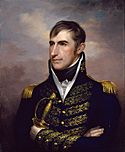
While Tecumseh was still in the south, Governor Harrison marched his army north. He had over 1,000 men. His goal was to scare The Prophet and his followers. He said he wanted them to agree to peace. But he also admitted he would attack them first if they refused. His army stopped near Terre Haute. They built Fort Harrison there to protect an important spot on the Wabash River.
At Fort Harrison, Harrison received orders from Secretary of War William Eustis. These orders allowed him to use force if needed to break up the Native American group at Prophetstown.
On November 6, 1811, Harrison's army arrived outside Prophetstown. Tenskwatawa agreed to meet Harrison the next day. Tenskwatawa might have thought Harrison planned to attack the village. So, he decided to attack first. He sent about 500 warriors against the American camp. Before dawn the next day, the Native Americans attacked. But Harrison's men held their ground. The Native Americans then left the village after the battle. Even though it was a surprise attack, the Americans won. They burned Prophetstown the next day and went back to Vincennes. This event is known as the Battle of Tippecanoe.
What Happened Next
Harrison and many historians later said that the Battle of Tippecanoe destroyed Tecumseh's confederacy. Harrison was later nicknamed "Tippecanoe." He eventually became President of the United States largely because of this victory. The battle was a big blow for Tenskwatawa. He lost his standing and his brother's trust. Even though it was a major setback, Tecumseh secretly began to rebuild his alliance when he returned from the south.
By December, most major American newspapers were reporting on the battle. Public anger quickly grew. Many Americans blamed the British for encouraging the tribes to violence and giving them guns. Andrew Jackson was one of the first to call for war. He claimed that Native Americans were "excited by secret British agents." Other governors in the west also called for action. William Blount of Tennessee urged the government to "purge the camps of Indians of every Englishmen to be found..." Because of public feeling, Congress passed statements condemning the British. They said Britain was interfering in American affairs. The Battle of Tippecanoe made tensions with Britain worse. This led to a declaration of war just a few months later.
As the Americans went to war with the British, Tecumseh found British allies in Canada. Canadians later remembered Tecumseh as a defender of Canada. But his actions in the War of 1812—which cost him his life—were part of his fight. He wanted to make sure Native Americans were independent and not controlled by others. Tecumseh continued this struggle until he died in the 1813 Battle of the Thames.
Images for kids


